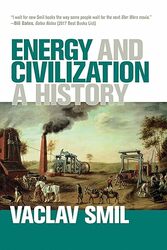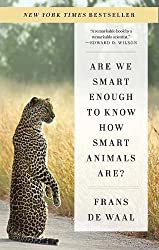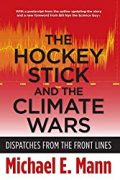
Rating: 7.8/10.
Book examining many aspects of life throughout history, with a focus on energy use. Energy may be considered a kind of universal currency that determines the quality of life across very different periods, from prehistoric societies to agriculture, the industrial revolution, and today. As civilization has advanced, we’ve gotten better at harnessing new forms of energy; the increasing energy density and efficiency of energy conversion are all associated with technological development. This book, in its various chapters, tells the history of humanity from the point of view of energy use, with detailed energy estimations and descriptions of facets of daily life in all manner of civilizations, such as how homes are heated, transportation, food production, moving heavy objects, etc. The overall theme achieved is that each era of technology was driven by new forms of energy that unlocked an order of magnitude more productivity, so when comparing today to pre-industrial times, there is a several orders of magnitude difference everywhere.
The writing style in this book is fairly academic, as it is an extension of the author’s previous academic book and reads more like a long survey paper than a typical nonfiction text. It uses academic citations directly in the text instead of footnotes; the text is filled with references to energy units, things like 700W, 100 kg N, 5 m^3/h, 240 kJ, 35 MJ/L, when describing various technologies and activities, that non-specialists would not have any intuition for. The author mostly does not bother to translate these figures into intuitive terms, so it would be lost on most readers, although without understanding all of the details, one can still get the broad picture.
The author begins by examining the energy efficiency and expenditure of prehistoric human activities such as walking, hunting, and foraging. The energy use can be analyzed by looking at the typical time it takes to perform an activity and how much food a human requires today as an estimate of energy input, and the amount of calories in the obtained food as energy output. Early agriculture involved a lot of labor in the planting and harvesting processes and was so intense that it was not obviously more labor-efficient than hunting and foraging. The use of animals for work was much more efficient energy-wise than human labor, as one horse had the equivalent of several humans. Even though it took some time to figure out a good set of equipment and harnesses, even crude equipment was more efficient than human labor. Further agricultural improvements include devices to move water for irrigation, using human and animal waste for fertilization, improving agricultural productivity due to its nitrogen content. Various cultures adopted farming technologies at different rates. China was the most advanced in the ancient times, leading to the highest population density in southern China. Improvement after 1750 reduced the hours of labor needed per hectare of farmland, increased productivity, and thereby increased population density as well. The diet in agricultural societies was universally monotonous, consisting of a single grain; famines and malnutrition due to crop failures were common.
Preindustrial labor relied on human and animal power, which was relatively limited – it often required huge quantities of people to gather the required force to do something. Systems of pulleys were widely used to magnify force and move heavy things. Compared to humans, who were limited by how many could effectively gather around an object, water mills were very important for grinding grain and could do the work of many people. Burning wood was the most popular way of producing heat, and charcoal, which was made from wood, was most valued as it provided the highest energy density compared to wood. Some cultures burned animal dung when it was available. Practical difficulties in setups for burning biomass for heat and light meant that efficiency was low. Some cultures built roads, and the Romans had the biggest system, which was more efficient for transporting goods, but was still much more expensive than any water-based transport, and immense human labor was required across centuries to construct these roads. The ancient people built large buildings such as the Egyptian pyramids – the challenge was feeding so many people, as probably 10,000 people worked at any time on pyramid construction. Copper was the first metal to be used, and use of iron came somewhat later because it required a higher melting point, therefore requiring the construction of a specialized furnace (copper could reach the melting point on an open fire). This was the limiting factor in iron production, since the high amount of heat required a large amount of wood to be burnt.
As energy needs rose, the world began to transition from wood to fossil fuels. Coal was the first fossil fuel to be widely used: it is mined underground and its use started in Britain in the 1600s. The Industrial Revolution, which happened in Britain, was mostly powered by coal-powered steam engines, and roughly by 1850, these engines unleashed 15x the available energy as compared to pre-industrial times. Railroads were the most practical for steam-powered transportation, and internal combustion engines powered early cars and planes. In 1880, Edison set up the first commercial system of electricity distribution, he defined the parameters of voltage and AC conversion, many of which are still used today. Although coal was the first fossil fuel, its use declined in most places (but it is still in use in China) because of high pollution, it has been mostly replaced by oil and natural gas, which can be transported in tankers and pipelines. The recent decades has led to increased efficiency, capacity, and reliability of electricity generation and, eventually, the adoption of renewable energy.
The rise of fossil fuels has led to a several orders of magnitude increase in available energy for many everyday use cases, compared to pre-industrial times. Synthetic nitrogen was pivotal in increasing agricultural productivity, so much so that we now have a food surplus, allowing us to afford to feed animals for meat production, instead of relying on a mainly vegetarian diet. Electricity has made many factories more energy-efficient compared to previous non-electric setups; steelmaking has also become more energy-efficient in the last 50 years. Transportation has gotten much faster, so much so that it is now possible to travel almost anywhere in the world within a day; the rise of cars first began in America and has now reached many parts of the world. GDP is strongly correlated with energy use in developing countries up to a certain point, after which it plateaus in developed countries where more advanced technological products, contribute value without high energy use. The increase in energy availability has led to urbanization, which would be impossible without efficient transportation, and also freed up labor for household chores. On a less positive note, the increased energy availability has also been reflected in the increasing power of modern weapons, which are many orders of magnitude more powerful than before.
Over the course of human history, the main source of energy has transitioned from human and animal power to water steam, then to fossil fuels, and now to renewable energy. This transition has occurred at different times, making it difficult to pinpoint exact dates for each of these shifts. There has been orders of magnitude of change in the availability of energy, as well as associated factors such as light and power-to-weight ratios of energy providers and engines. We now have enough energy that we can afford to use it in ways that could be considered frivolous, such as traveling for pleasure or using private cars for convenience, despite their lack of energy efficiency, although this level of luxury and energy abundance is only achieved in developed countries. The abundance of energy has transformed society at every level, to the point where we are dependent on it and cannot revert to an earlier state without risking total collapse. However, energy use is not the only contributing factor to human well-being; the author concludes by emphasizing the need to decouple future progress from increasing energy use, due to its devastating environmental consequences.



